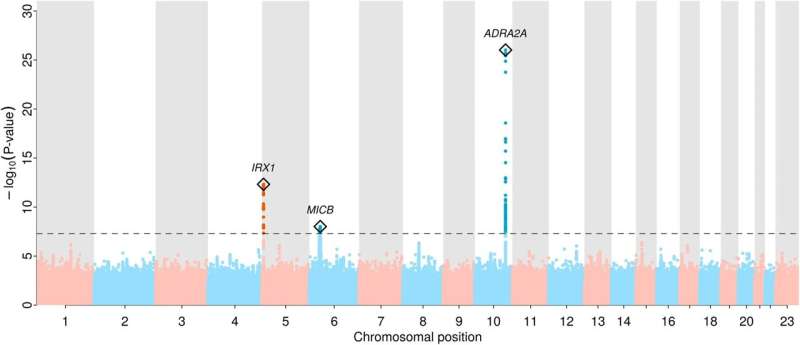This article has been reviewed according to Science X's editorial process and policies. Editors have highlighted the following attributes while ensuring the content's credibility:
fact-checked
peer-reviewed publication
proofread
First genetic causes of Raynaud's phenomenon discovered

Two to five percent of all people are affected by Raynaud's phenomenon: In cold or stressful conditions, the small blood vessels that supply the skin constrict and the fingers or toes turn white. First described by Maurice Raynaud in 1862, scientists from the Berlin Institute of Health at the Charité (BIH), together with colleagues from the United Kingdom, have only now discovered a common genetic causes of the disease and published it in the journal Nature Communications.
Maurice Raynaud had studied people reporting that the fingers turn frequently white during the day in his doctoral thesis in Paris in 1862: 25 affected people, 20 women and five men, showed the conspicuous changes in fingers and toes in cold weather, which sometimes led to the death of the limbs.
"Fortunately, this only happens very rarely today," says Dr. Maik Pietzner, co-lead of the Computational Medicine group at BIH. "But the four-to-one ratio between women and men and the symptoms described are still hold true, but the disease is understudied and there is still no really effective treatment. We therefore aimed to find genetic causes of Raynaud's phenomenon."
Data from >5,000 patients in UK biobank
In their search for the genetic causes of the disease, the scientists led by Maik Pietzner and Professor Claudia Langenberg, who heads the Computational Medicine Unit at BIH and is also Director of the newly founded Institute for Precision Medicine at Queen Mary University in London, UK, turned to the UK Biobank study.
"The study uniquely combines genetic information on more than 500,000 participants that have also been linked to their electronic health records," Claudia Langenberg describes the great treasure trove of data. "In this way, we were able to identify more than 5,000 people affected by Raynaud's and could study how common variation in the genome predisposes to the disease, when did Raynaud's phenomenon first occur, and what concomitant diseases do the people suffer from?"
Blood vessels constrict quickly and only slowly dilated
In their analyses, the scientists discovered variation in two genes that predisposed participants to Raynaud's phenomenon: One was the alpha-2A-adrenergic receptor for adrenaline, ADRA2A, a classic stress receptor that causes the small vessels to contract. "This makes sense when it's cold or dangerous, because the body has to supply the inside of the body with blood," explains Maik Pietzner.
"In Raynaud's patients, however, this receptor seemed to be particularly active, which could explain the vasospasms, especially in combination with the second gene that we found: This gene is the transcription factor IRX1, which may regulate the ability of blood vessels to dilate."
If its production is increased, the constricted vessels cannot relax as they would normally do. Together with the overactive adrenaline receptor, this may then lead to the vessels not suppling enough blood for a longer period of time, which leads to the observed white fingers and toes.
The scientists' findings also help to understand for the first time why the small vessels react so strongly in patients, even apparently without external stimuli, especially cold. Pragmatic recommendations for patients could also be derived from their findings.
For example, the scientists were able to show that people with a genetic predisposition to low blood sugar levels have an increased risk of Raynaud's phenomenon and therefore patients should possibly avoid longer episodes of low blood sugar. Pietzner and colleagues were also able to replicate parts of their findings in the independent Genes & Health study, thus also showing the relevance for ethnic minorities, especially British Bangladeshi and Pakistani.
From genes to drugs
"Our results neatly align with what we observe in patients," says Claudia Langenberg. "They can explain well why the blood vessels of patients with Raynaud's quickly become narrow and only slowly widen again." Maik Pietzner adds, "They also explain why many drugs used so far do not work: they are directed against mechanisms that often dilate the large vessels, but apparently not the very small vessels in our hands and feet that are affected in patients with Raynaud's."
But the scientists also offer hope. For example, already approved drugs that more or less specifically inhibit the function of ADRA2A could be an alternative, such as the antidepressant mirtazapine. "I am convinced that our findings provide a path to novel effective medications," says Claudia Langenberg and adds, "Our study demonstrates how valuable information from electronic health records is for patient-oriented research and that more needs to be done, especially in Germany, in order to achieve better care more quickly."
More information: Sylvia Hartmann et al, ADRA2A and IRX1 are putative risk genes for Raynaud's phenomenon, Nature Communications (2023). DOI: 10.1038/s41467-023-41876-5
Journal information: Nature Communications
Provided by Berlin Institute of Health in der Charité




















